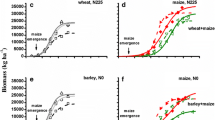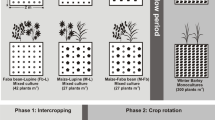Abstract
This paper reviews recent research on the processes involved in the yield advantage in wheat (Triticum aestivum L.)/maize (Zea mays L.), wheat/soybean [Glycine max (L.) Merr.], faba bean (Vicia faba L.)/maize, peanut (Arachis hypogaea L.)/maize and water convolvulus (Ipomoea aquatica Forsk.)/maize intercropping. In wheat/maize and wheat/soybean intercropping systems, a significant yield increase of intercropped wheat over sole wheat was observed, which resulted from positive effects of the border row and inner rows of intercropped wheat. The border row effect was due to interspecific competition for nutrients as wheat had a higher competitive ability than either maize or soybean had. There was also compensatory growth, or a recovery process, of subordinate species such as maize and soybean, offsetting the impairment of early growth of the subordinate species. Finally, both dominant and subordinate species in intercropping obtain higher yields than that in corresponding sole wheat, maize or soybean. We summarized these processes as the `competition-recovery production principle'. We observed interspecific facilitation, where maize improves iron nutrition in intercropped peanut, faba bean enhances nitrogen and phosphorus uptake by intercropped maize, and chickpea facilitates P uptake by associated wheat from phytate-P. Furthermore, intercropping reduced the nitrate content in the soil profile as intercropping uses soil nutrients more efficiently than sole cropping.
Similar content being viewed by others
References
Crawley M J 1997 Plant Ecology. Blackwell Science, Cambridge.
Geno L and Geno B 2001 Polyculture Production-Principles, Benefits and Risks ofMultiple Cropping Land Management Systems for Australia. A report for the rural industries research and development corporation. CIRDC Publication No 01/34.
Ghaffarzadeh M, Prechac F G and Cruse R M 1994 Grain yield response of corn, soybean, and oat grown in a strip intercropping system. Am. J. Altern. Agric. 9, 171-177.
Gomez A A and Gomez K A 1983 Multiple cropping in the Humid Tropics of Asia, IDRC 176E, IDRC, Ottawa.
Jensen E S 1996 Grain yield, symbiotic N2 fixation and interspecific competition for inorganic N in pea-barley intercrops. Plant Soil 182, 25-38.
Li L, Sun J H, Zhang F S, Li X L, Yang S C and Rengel Z 2001a Wheat/maize or wheat/soybean strip intercropping. I. Yield advantage and interspecific interactions on nutrients. Field Crops Res. 71, 123-137.
Li L, Sun J H, Zhang F S, Li X L, Rengel Z and Yang S C 2001b Wheat/maize or soybean strip intercropping. II. Recovery or compensation of maize and soybean after wheat harvesting. Field Crops Res. 71, 173-181.
Li L, Yang S C, Li X L and Zhang F S and Christie P 1999 Interspecific complementary and competitive interaction between intercropped maize and faba bean. Plant Soil 212, 105-114.
Li L, Zhang F S, Li X L, Christie P, Sun J H, Yang S C and Tang C 2002a Interspecific facilitation of nutrient uptakes by intercropped maize and faba bean. Nutr. Cycl. Agroecosyst. (in press).
Li L, Tang C, Rengel Z and Zhang F S 2002b Chickpea facilitates phosphorous uptake by intercropped wheat from an organic phosphorus source. Plant Soil 248, 297-303.
Marschner H 1995 Mineral Nutrition of Higher Plants. Academic Press, London.
Rao I M, Borrero V, Ricaurte J and Garcia R 1999 Adaptive attributes of tropical forage species to acid soils. V. Differences in phosphorus acquisition from less available in organic and organic sources of phosphate Plant Nutri. 22: 1175-1196.
Richards I R, Wallace P A and Paulson G A 1996 Effects of applied nitrogen on soil nitrate-nitrogen content after harvest of winter barley. Fert. Res. 45, 61-67.
Stuelpnagel R 1993 Intercropping of faba beans (Vicia faba L.) with oats or spring wheat. In Proceedings of the International Crop Science Congress, 14-44, July, 1992. Iowa State University, Ames, Iowa.
Tong P Y 1994 Achievements and perspectives of tillage and cropping systems in China (in Chinese), Cropping System and Cultivation Technology (Genzuo Yu Zaipei). 77, 1-5.
Van der Meer J 1989 The Ecology of Intercropping. Cambridge University Press, New York.
West T D and Griffith D R 1992 Effect of strip-intercropping corn and soybean on yield and profit. J. Prod. Agric. 5, 107-110.
Willey RW1979 Intercropping-its importance and research needs. Part 1. Competition and yield advantages. Field Crop Abstr. 32, 1-10.
Willey R W and Rao M R 1980 A competitive ratio for quantifying competition between intercrops. Exp. Agric. 16, 117-125.
Zhang F S, Li L and Sun J H 2001 Contribution of above-and belowground interactions to intercropping. In Plant Nutrition-Food Security and Sustainability of Agro-ecosystems. Ed. Horst et al. pp. 979-980. Kluwer Academic Publishers, Doirdrecht.
Zhou X M, Chandra A M, Angus F M, Kaluli J W and Smith D L 2000 Corn yield and fertilizer N recovery in water-tablecontrolled corn-rye-grass. Eur. J. Agron. 12, 83-92
Zuo Y M, Zhang F S, Li X L and Cao Y P 2000 Studies on the improvement in iron nutrition of peanut by intercropping with maize on a calcareous soil. Plant Soil 220, 13-25.
Author information
Authors and Affiliations
Corresponding author
Rights and permissions
About this article
Cite this article
Zhang, F., Li, L. Using competitive and facilitative interactions in intercropping systems enhances crop productivity and nutrient-use efficiency. Plant and Soil 248, 305–312 (2003). https://doi.org/10.1023/A:1022352229863
Issue Date:
DOI: https://doi.org/10.1023/A:1022352229863




